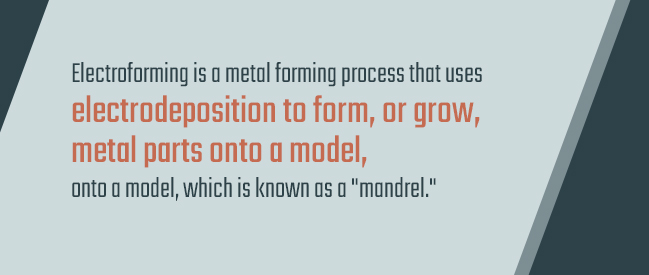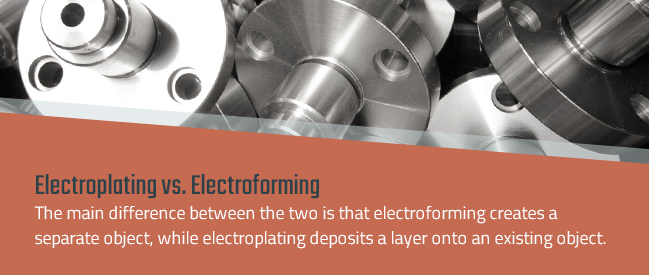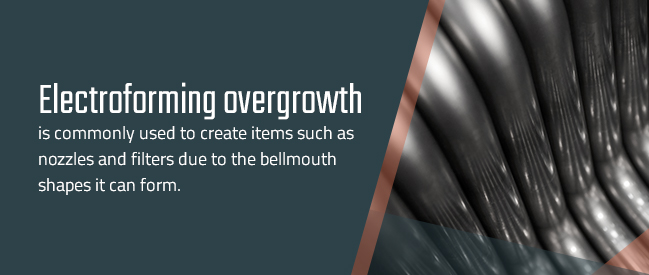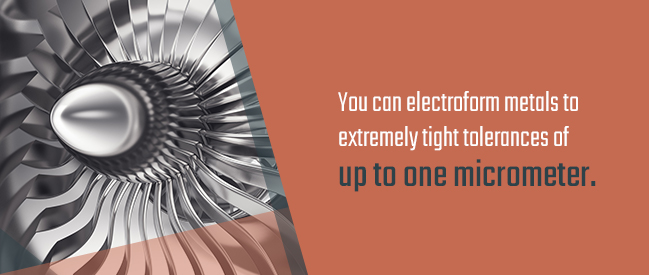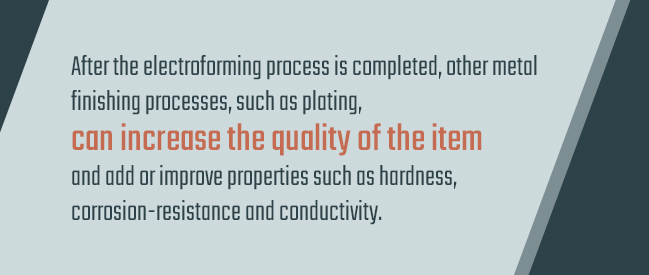Many different processes, from forging to deep drawing to casting, are used to form metal — and most of them involve applying some sort of effective stress to a metal. These methods are useful for a range of applications, but did you know that you can also “grow” metal? When working on a complex project that requires extreme precision, this technique — which is known as “electroforming” — may be your best bet.
What Is Electroforming?
Electroforming is a metal forming process that uses electrodeposition to form, or grow, metal parts onto a model, which is known as a “mandrel.” Electrodeposition involves the electrochemical transfer of metal ions through an electrolyte to a surface from an anode.
The mandrel determines the shape of the final product, which may be referred to as an “electroform.” This mandrel is conditioned such that the metal being deposited does not adhere to it. After the process is complete, the mandrel is typically removed. The outer surface of the mandrel creates the inner surface of the finished product and the metal that formed around the mandrel retains the shape created by electrodeposition. This metal form is the finished product.
This technique allows for high accuracy and the creation of complex shapes. The surface of the form that was touching the mandrel is highly accurate with respect to the desired shape of the model. The outside areas won’t be as well-defined, but you can add as much thickness as needed to the piece on the outside layers. The metal layers can be extremely thin if desired. It only needs to be thick enough to support itself.
Electroplating vs. Electroforming
Electroforming is often confused with a process called “electroplating.” The processes have some similarities but produce different results and have different applications.
Electroforming and electroplating are both used in the manufacturing of metal products and they both rely on the electrodeposition process. While electroforming creates a product that is separate from the model, the metal deposited in electroplating becomes part of the surface it’s deposited on. A product made by electroforming is usually created entirely through electroforming, while electroplating forms just the outer layer of a product.
Electroplating is used to deposit a thin coating on the outside surface of an object, typically to enhance its appearance or functionality in some way. You might use electroplating to improve the cosmetic appeal of an object or its hardness, resistance to corrosion, conductivity or many other things. The process can be applied to a wide range of objects, including electroforms, and the plating can be made of a variety of metals.
In short, the main similarities between electroforming and electroplating are as follows:
- They are both used in the manufacturing of metal objects.
- They both use the electrodeposition process.
- You can use a variety of metals for both processes.
The main difference between the two is that electroforming creates a separate object, while electroplating deposits a layer onto an existing object.
How Does the Electroforming Process Work?
The electroforming process begins with a metal substrate with a textured surface — the mandrel. You must clean and degrease the substrate and then apply a photo-sensitive coating. You then cover the areas to which you do not want the metal ions to adhere with a film photomask. This is transferred to the surface through exposure to ultraviolet light, creating a “negative” of the final product.
Next comes the electrodeposition phase of the process, which is what causes the metal to form on the mandrel.
Electrodeposition is, at its most basic, the method used to deposit metal onto a conductive surface. This process involves immersing an anode and a cathode in an electrolytic bath made of a solution of salt and the metal that will be deposited onto the object. You pass a direct electric current (DC) through the salt-and-metal solution, which transforms the metallic ions into atoms and causes them to deposit onto the cathode, which is the object that will receive the metal. This allows you to build up the object essentially atom by atom, allowing for the high levels of accuracy for which electroforming is known.
In electroforming, the atoms will only adhere to the parts not masked with the film photomask. One the metal has grown on the mandrel to the desired thickness, you remove it from the electrolytic bath. If you’re going to remove the mandrel, as is the case with a majority of projects, you will either keep it intact and separate it or dissolve it away. Sometimes — especially if the electroforming serves a decorative purpose — you will leave the mandrel in place.
There are two different methods of electroforming used to control the shape of the finished product: Electroforming overgrowth and electroforming thick-resist.
Electroforming overgrowth is plating-defined and uses a thin photoresist pattern that covers parts of the conductive substrate that will polymerize under UV light. The metal forms over the photoresist pattern and is allowed to grow over the sides of the model. The size of the apertures depends on the overgrowth of the electroforming process, which means the plating process defines the product’s accuracy. This method is commonly used to create items such as nozzles and filters due to the bellmouth shapes it can form.
The thick-resist method is photo-defined because its accuracy is defined by the photolithographic process. It involves depositing the metal material below the height of the photoresist. No overgrowth is allowed, resulting in straight-lined walls. This type of model creates a two-dimensional structure with straight sidewalls and you can also apply multiple cycles of the process to create quasi-three-dimensional structures. The height of the photoresist determines the height of the electroform.
Electroforming With Non-Conductive Materials
Up to this point, we’ve covered electroforming with conductive metals as a substrate. This required blocking off the parts of the mandrel where you did not want metal to form. You can also use electroforming with non-conductive materials such as plastics and glass.
The process of electroforming with a non-conductive mandrel is similar to the process involving a conductive mandrel, but you have to do the beginning steps in an opposite manner. To clarify, instead of covering the parts of the surface where you don’t want metal to form, you have to make the areas where you do want coverage conductive so that metal will grow there. You do this by applying a conductive coating to the desired parts of the model, which you can do manually, chemically or with vacuum deposition techniques. Manual methods are common and include painting or spraying on a conductive metallic paint that creates a thin film on the substrate, often comprised of nickel or silver.
Once the conductive film is applied to the mandrel, you can go through the electroforming process as you would with a conductive substrate.
Advantages of Electroforming
There are several advantages when you choose electroforming for your product:
- High Accuracy: You can electroform metals to extremely tight tolerances of up to one micrometer. The fact that you create the metal layer atom by atom allows for extremely fine details on its surface and extremely small components. You also won’t see any tool marks or shrinkage like you would with other metal forming techniques.
- Complexity: Electroforming lends itself well to producing complex shapes because the electroform is created from the negative image of the mandrel. This makes electroforming useful for a wide variety of applications. Many of the shapes that are difficult to create via other methods are easily produced with electroforming. The method is especially useful for accurately manufacturing internal cavities.
- Light Weight: The walls of an electroformed object can be extremely thin. They only need to be thin enough that they hold together and won’t be damaged by regular handling. These thin components are also lightweight, which is especially useful in the automotive and aerospace fields.
- Metal Purity: The way the metal layer forms, atom by atom, results in extremely pure metal. This purity increases the quality of the metal and characteristics such as hardness, malleability and conductivity.
- Highly Flexible: Electroforming is a relatively flexible metal manufacturing technique and has a wide range of applications across industries. You can make extremely small components as well as large ones. The size of the item is only limited by the size of the plating tank.
It’s also useful for both low- and high-volume production runs. You can use a permanent mandrel for high-volume production runs. For short runs, you can use a disposable mandrel that you melt or dissolve away from the electroform.
You can also incorporate other components into the product of the initial electroforming process and add parts onto after this first step as necessary. It’s also possible to join two components via electroforming. After the electroforming process is completed, other metal finishing processes, such as plating, can increase the quality of the item and add or improve properties such as hardness, corrosion-resistance and conductivity.
Disadvantages and Challenges
The outside surface of the electroform is often less precise than the inside part of the form, especially when the overgrowth method is used. The thicker the object, the more definition is lost. Excess material can sometimes build up on outside corners and edges, but this unwanted material can be etched away.
Certain challenges can also sometimes arise during the electroforming process — especially when removing the mandrel from the finished part. The final product might also not have all the properties you need, but this problem can often be resolved by plating the object, especially with copper or palladium.
Have a Product or Want to Learn More About Plating?
SPC provides expert plating and metal finishing services to clients in a wide variety of industries. If you have an electroformed product that you’d like to enhance with plating, or you want to learn more about the various plating methods and materials we provide, contact us today or request a free quote. You can also browse our website for a variety of plating and metal finishing resources.


